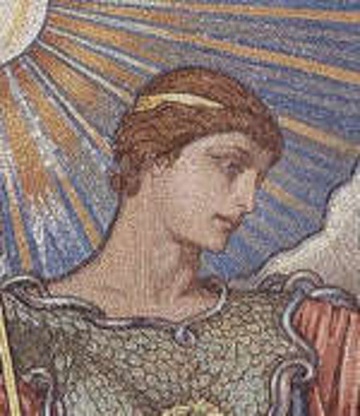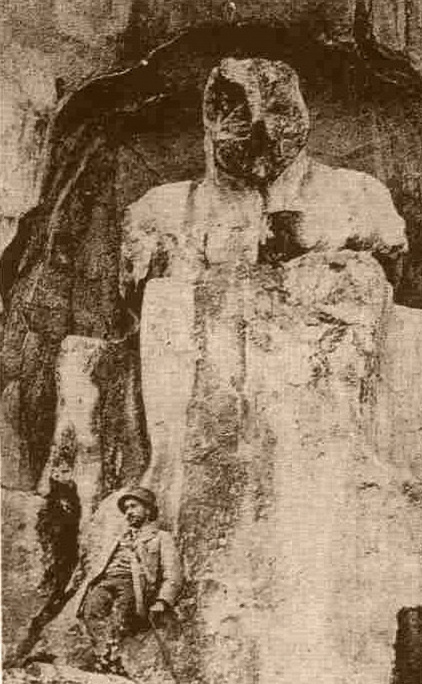
Broteas

In Greek mythology, Broteas (Ancient Greek: Βροτέας), a hunter, was the son of Tantalus (by Dione, Euryanassa or Eurythemista), whose other offspring were Niobe and Pelops.
Broteas was also one of the Lapiths, killed at the battle of the Lapiths and the centaurs.
Mythology
Broteas was the son of Tantalus, born to either the Hyades nymph Dione, the Naiad Euryanassa, or the Naiad Eurythemista. Thus Broteas was brother to Pelops and Niobe.
The actions of Tantalus would see the king eternally tormented in Tartarus, and a curse would pursue several generations of the family line, taking in the generations of Pelops, Atreus, Agamemnon and Orestes.
Though nominally a hunter, Broteas was proclaimed as a great sculptor, a sculptor who carved the image of Cybele unto a crag called Coddinus upon Mount Sipylus, in the realm of his father. This relief is today equated with the remnants of the Manisa relief in Turkey.
The goddess observed the work of Broteas and asked that he also sculpt a likeness of her upon the mountain.
Broteas though refused the goddess’ request, and in retribution, Artemis sent madness down upon the hunter, and thus Broteas threw himself upon a pyre, killing himself.
Broteas was occasionally said to have had a son named Tantalus, by a woman unnamed. This Tantalus would become king of Lydia, and some stated that he was actually the first husband of Clytemnestra, the daughter of King Tyndareus, but was killed by Agamemnon, who then took Clytemnestra as his wife.
Manisa relief
This ancient rock carving was famous in antiquity. It's located near the town of Magnesia ad Sipylum, and it was believed to have been carved by Broteas. He was said to have carved the most ancient image of the Great Mother of the Gods (Cybele), an image that in Pausanias' day (2nd century CE) was still held sacred by the Magnesians.

The sculpture was carved into the rock-face of the crag Coddinus, north of Spil Mount-Mount Sipylus, whose daemon was one of the mythographers' candidates for Broteas' grandfather.
The rock-cut carving mentioned by Pausanias was identified with the Manisa relief in 1881 by W. M. Ramsay and is still to be seen above the road about 6 or 7 km east of Manisa (the modern descendant of Magnesia ad Sipylum), though the head has partly cleaved away, from natural causes.
The figure 8–10 metres high carved in a recess in the a cliff-face a hundred metres above the marshy plain near the village of Akpinar, has come to be confused with a nearby natural rock formation associated with Niobe, the "Niobe of Sipylus" (the "Weeping Rock", in Turkish Ağlayan Kaya), also mentioned by Pausanias.

Apart from the badly damaged head, the sitting figure is clear enough to be made out by a non-professional. The goddess with the polos headgear holds her breasts with her hands; a vague trace of four Hittite hieroglyphics could be seen on a squared section to the right of her head. The site is Hittite, second millennium BCE.
Nearby, other archaeological sites traditionally associated with the House of Tantalus since Antiquity are also in fact Hittite. Some 2 km east of Akpınar there are another two monuments on Spil Mount, which are also mentioned by Pausanias: the tomb of Tantalus (Christianized as "Saint Charalambos' tomb") and the "throne of Pelops", in fact a rocky altar.
Broteas in the Renaissance
In literature of the Renaissance and later, Broteas is most often called "Brotheus" and described as a son of Vulcan who cast himself into the flames, sometimes specified as those of Mount Aetna, because of his deformity. The immediate source for the Renaissance trope of Brotheus and his self-immolation was Ovid's curse poem Ibis, an erudite rant of gruesome threats cataloguing the fates of numerous mythic and historical figures.
Ovid's reference is minimal: "May you consign your body parts, set on fire, to the pyre to be cremated, as they say Broteas did out of a desire for death."

Sources
Robert Graves, 1960. The Greek Myths (Section 108).
Pausanias, Greece, iii.22.4.
Apollodorus, Epitome, i.24; ii.2.
Ovid, Ibis, line 517 (with scholiast noted by Graves).
Ovid. Metamorphoses xii, 260
Pausanias. Descriptions of Greece, iii.22.4. "the Magnesians, who live to the north of Mount Sipylus (Spil Mount), have on the rock Coddinus the most ancient of all the images of the Mother of the gods. The Magnesians say that it was made by Broteas the son of Tantalus."
"Wikipedia"
Our Mobile Application
Check out Our Mobile Application "Ancient Greece Reloaded"


